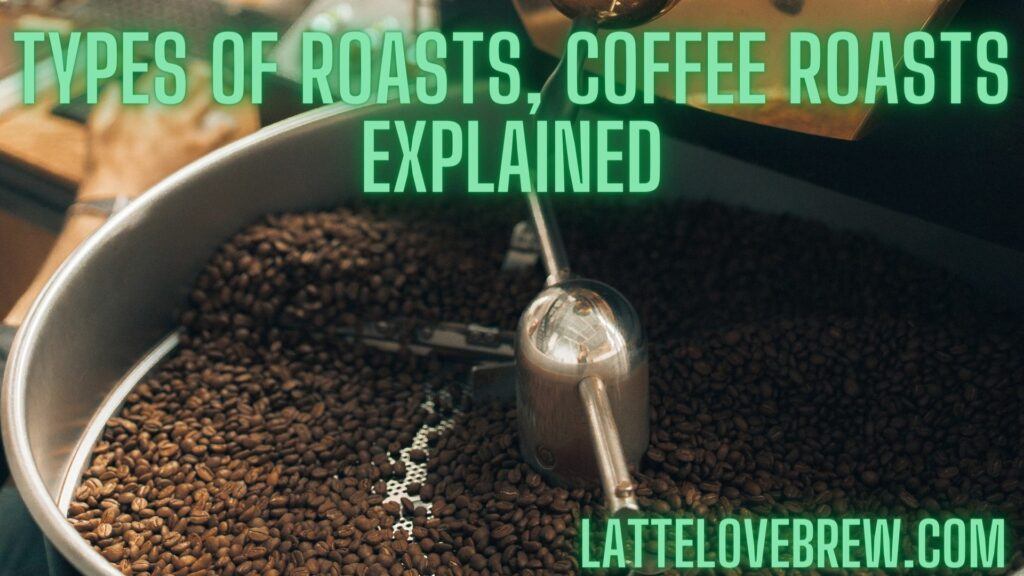Last updated on January 22nd, 2024 at 13:25
Getting to know the different types of roasts coffee can seem a little complicated: French roast, Italian roast, full city roast, Espresso, medium roast and so on.
What are they and what do they mean?
In this article I fully explain what the different coffee roasts are with the goal of helping you to understand the different roasts and how they affect the taste of your coffee.
Pardon the pun, let’s get cracking!
What Does The Roasting Process Do?
Table Of Contents
- 1 What Does The Roasting Process Do?
- 2 What Are The Different Coffee Roasts? Different Coffee Roasts Explained!
- 3 How Does Roast Affect Coffee Taste?
- 4 Coffee Roast Levels And Caffeine
- 5 Frequently asked Questions About Types Of Roast Coffee
- 6 Frappé-Ing It All Up – Types Of Roasts Coffee Roasts Explained
The coffee roasting process turns the seed of a coffee cherry from a green, earthy bean with a grassy smell into the coffee beans that we are more familiar with that result in the cup of coffee that we enjoy drinking.
The coffee roasting process takes those coffee beans, toasts them, changing their color to a predetermined darker color, giving them caramelized flavors and chocolatey and nutty notes.
Roasting causes numerous chemical changes and reactions to occur which turn those seeds into the beans that can be used for making a cup of coffee. The roasting temperature and roasting time play an important role in what the end result will be.
At higher temperatures, the coffee oils appear as a shiny surface on the beans. At 401F (205C) expand and crack for the first time, known as the first crack. At 437F (225C), the second crack occurs.
If you are home roasting, never roast your high quality coffee beans at a temperature above 482F (250C). Beyond that temperature, your beans will just become burnt, and end up with a full on charcoal ash-like taste.
Unfortunately, there is no standard universal naming of roasts or descriptions in the coffee industry. However, with a keen and trained eye, you will be able to identify the different roast levels by their color.
At Latte Love Brew we encourage you to get in on the home roasting revolution for the ultimate fresh coffee experience.
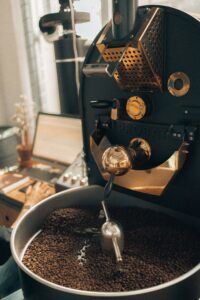
Read: Best roast for Ethiopian Yirgacheffe
What Are The Different Coffee Roasts? Different Coffee Roasts Explained!
I’ve been emailed and messages on social media few times asking me what the three roast levels of coffee are. There are actually four main roast levels with many more roasts within those levels.
I seriously wish that there was some kind of universal regulation on roasts and names!
What Are The Three Roast Levels Of Coffee?
Addressing the question I get asked a lot. Strictly speaking, there are three roast levels, which are light roast, medium roast and dark roast.
However, there is a very common fourth level that is a bridge between medium and dark named, imaginatively, medium dark roast.
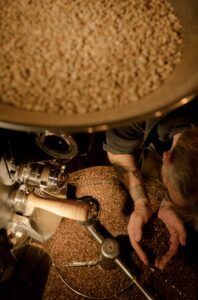
The Different Coffee Roast Levels
Let’s get to the meat and bones of this article and talk in more detail about the different levels of coffee roasting and what they are and what they mean exactly.
Light Roast Coffee Beans
This is the first of the four types of coffee roast and are roasted for the shortest period of time and at the lowest temperature. The internal temperature of lightly roasted beans is within the 356F to 401F (180C to 205C) and are roasted until the first crack.
The coffee oils are still locked inside the beans and have not yet come to the surface to coat the beans. Light roast coffee beans are easily identifiable as the lightest of all roasts and their non-oily surface.
Light roasts have a greater caffeine content and are more acidic than the other coffee roasts as the roasting process pulls out the caffeine. As you up the roasts from light to dark, the caffeine level as acidity levels drop slightly.
Due to being roasted at a lower temperature and for a shorter period of time, this roasting process does not have as many chemical reactions and changes happening inside the beans. This leaves all the origin flavors are still in the beans, waiting for you to brew them out and into your cup of coffee.
Cinnamon roast, half city roast and New England roast and blonde roasts are all light roasts.
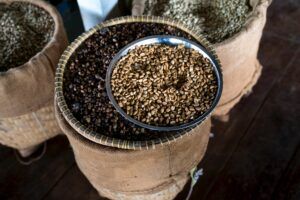
Medium Roast Coffee Beans
Medium roasted coffee beans are roasted to an internal temperature range of 410F to 428F (210C to 220C) and beyond the first crack and before the second crack. The typical American coffee drinker is most familiar with this roast. They are less acidic than a light roasts and have less caffeine.
A medium roast has slightly more body and is a middle of the spectrum roast. Your specialty single origin beans can also be roasted to this level also without losing too much of their flavors.
City roast, American roast and breakfast roast are examples of medium roasted beans.
Medium Dark Roast Coffee Beans
Medium-dark roasted coffee beans are roasted to an internal temperature range of 437F to 446F (225C to 235C). This roast is taken to the point of the second crack or slightly after it. This level of roast has a semi oily surface as the coffee oils are only starting to come to the surface of the coffee beans.
This type of roast, as a result, has a fuller flavor that is deeper, richer and less acidic. A common and popular medium dark roast coffee blend is a full city roast and Vienna roast.
Dark Roast Coffee Beans
The dark coffee roast is perhaps the one that you are most familiar with. The roasting temperature for this roast is typically from 464F to 482F (240C to 245C). A dark roast is easily identified with its dark color and shiny surface due to the oil on surface of the beans. This type of coffee bean has none of the origin flavors as they have all been roasted out during the roasting process.
You can expect richer, sweeter, more full-bodied flavors with less caffeine and less acidity than all other coffee roasts. The darkest of the dark roasts is a French roast which has a smoky, deep, deep, almost ash-like burnt flavor.
Italian roast, espresso roast, and Turkish roasts are all popular dark roasted coffee beans.
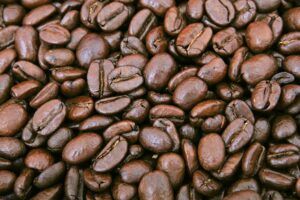
What Do The Different Coffee Roast Levels Taste Like?
Since I have already touched on the main difference between coffee roasts and the flavor profiles, I’ll simply summarize what you can expect with each roast:
- Light Roast: Expect a clear, bright mild cup of coffee with a pronounced acidity and the origin flavors of the beans.
- Medium Roast: Expect a slight sweetness and aroma, and a nice balanced coffee.
- Medium-Dark Roast: Expect a reduced acidity, heavier body and more chocolate-like notes.
- Dark Roast Coffee: Expect a full-bodied coffee with a smoky taste and more pronounced dark chocolate notes.
Naturally this is only a guide to how coffee should taste at each roasting profile. The end result will vary depending on your coffee beans and how fresh they are as well as other aspects.
How Does Roast Affect Coffee Taste?
The roasting of coffee beans is one of the biggest factors in coffee taste. Few things influence the taste more than roasting.
The roasting of green coffee beans transforms the green beans from something that simply cannot be used to make any drink, let alone coffee due to a rather grassy taste, to a delicious and tasty flavorful coffee.
Roasting to different levels does a lot more than just giving the beans a different color. They change their attributes and tastes significantly.
Coffee Roast Levels And Caffeine
The relationship between the coffee roast level and caffeine content is not something to be focused on at all as the difference is insignificant. Sure, there is a difference.
The difference between a light roast, a blonde roast espresso for example and a dark espresso roast is only 10 mg.
The lighter the roast, the more caffeine it contains. However, how much caffeine is in your cup of coffee, other variables, such as your brewing method, have a greater effect.
Frequently asked Questions About Types Of Roast Coffee
What Type Of Roast Is Best Coffee?
The best roast for coffee depends on the type of coffee you want to make and your own personal taste. If you want the unique flavors from the beans and their origins, then a light roast will best for you and subsequently the best brewing method would be a pour over.
If you enjoy the deep, dark taste from the roasting process then a dark roast will be better for you and espresso and French press brewing being good brewing techniques.
If you enjoy the best of both worlds, then the best roast for coffee for you would be a medium roast which has balance of flavors from both the beans and the roasting process.
What Are The 3 Roast Levels Of Coffee?
The three main roast levels of coffee roasts are light, medium and dark roast.
What Is The Most Popular Coffee Roast?
The most popular coffee roast based on the volume sold per year is a medium roast coffee. It is much enjoyed for the balanced flavor, having a good mix of the origins and of the roasting process.
Which Roasts Coffee Beans Better, Electric Or Gas Roasters?
The majority of commercial coffee roasters use gas as it is much easier for the roaster to control the temperature by simply adjusting the flow of gas.
Electric roasters are more popular for home use. Once you are experienced at roasting and can think 10 to 15 seconds ahead of time, you will get the same results with an electric home roaster as you would a gs roaster.
Unfortunately there are few gas-powered home roasting equipment.
How Long Does It Take To Roast Coffee?
When you are not familiar with coffee roasting or inexperienced with the process of roasting coffee, it is a good idea to use the presets. Be careful not to overfill your roasting machine.
Drum roasters can take up to 14 to 20 min for coffee to roast while your air roaster can take from 8 to 12 minutes.
The lower the temperature, the longer it will take your coffee to roast. Also, the roast profile that you want to roast your coffee beans to will have an effect on the time taken.
Why Do People Roast Coffee Into The Second Crack?
A full city roast and the Vienna Roast offer an abundance of flavor and only once that second crack has been reached. These two dark roasts are nowhere near a French roast or an Italian Roast, which is well beyond the second crack.
Just after the second crack, this is where the flavors are more alive, richer, sweeter and more earthy.
Frappé-Ing It All Up – Types Of Roasts Coffee Roasts Explained
I have covered all the types of roasts coffee and detailed how the roast level affects the coffee taste and what you can expect from a particular roasting level in terms of flavor.
The effect of roasting is the most dramatic there is in determining how a bean will taste. If you have any questions about coffee roasts – shoot me a message on the Latte Love Brew Facebook page.
Join our fab, fun and informative coffee community on Facebook/Meta and take part by sharing your favorite funny coffee jokes, coffee memes, quotes and your fab coffee creations.

